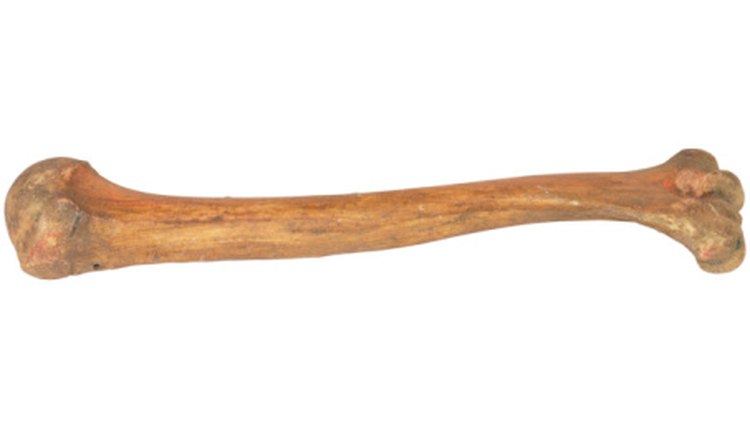What does fact checked mean?
At SportsRec, we strive to deliver objective content that is accurate and up-to-date. Our team periodically reviews articles in order to ensure content quality. The sources cited below consist of evidence from peer-reviewed journals, prominent medical organizations, academic associations, and government data.
The information contained on this site is for informational purposes only, and should not be used as a substitute for the advice of a professional health care provider. Please check with the appropriate physician regarding health questions and concerns. Although we strive to deliver accurate and up-to-date information, no guarantee to that effect is made.
The Size & Strength of the Femur in Women

The femur is the largest bone in the human body. The femur carries the weight of the entire body, and you can't move your body without it. The femur starts at the hip in a socket joint, and travels down to the knee joint. Gerard J. Tortora and Bryan Derrickson, authors of "Principles of Anatomy and Physiology," state that bone degradation typically starts at the end points of the bone, and you want to keep your femur strong as it is connected to the two problematic areas of the hip and knee.
Size
According to Tortora and Derrickson, the adult female femur bone has an average length of 17 to 18 inches, and an average diameter of 1 inch. The average weight of a adult female femur is 261 g, which equals out to roughly 9.2 oz.
Strength
The American College of Sports Medicine states that the typical healthy adult female femur can support 30 times the weight of the body. The amount of weight your femur can support depends on your level of physical activity, if you perform resistance exercises and your diet. Your femur can support more than 30 times your body weight if you are physically active, partake in resistance training and have a healthy intake of calcium, vitamin D and phosphorus.
Increasing Femur Strength and Integrity
The American College of Sports Medicine suggests resistance training to increase both the strength and thickness of your bones. Resistance training applies unusual stress and stimulus onto your bones, which increases cellular activity within the bone matrix in order to adapt to the new stresses. The National Strength and Conditioning Association suggests using free weight exercises that load the spine and hips to encourage bone growth in the femur.
Osteoporosis/ Osteopenia
Many health organizations, such as the National Strength and Conditioning Association and the American College of Sports Medicine, report on the importance of considering your bone health as a woman, and partaking in exercises that load your bones. The National Women's Health Information Center states that women are at a much greater risk for developing osteoporosis than males due to the female genetic make up, hormone levels and physiological set-up of a woman's body. You should incorporate resistance training into your exercise routine in order to maintain bone strength and integrity. Daily activities of living will become greatly affected if your femur--as the largest bone in the human body and necessary for all leg actions--begins to suffer from osteoporosis.
References
- "Principles of Anatomy and Physiology, 11th edition"; Gerard J. Tortora and Bryan Derrickson; 2006
- "ACSM's Guidelines for Exercise Testing and Prescription, 8th edition"; American College of Sports Medicine; 2009
- "Essentials of Strength Training and Conditioning"; Thomas R. Baechle, Roger W. Earle; 2008
- Fuchs RK, Kersh ME, Carballido-Gamio J, Thompson WR, Keyak JH, Warden SJ. Physical Activity for Strengthening Fracture Prone Regions of the Proximal Femur. Curr Osteoporos Rep. 2017;15(1):43–52. doi:10.1007/s11914-017-0343-6
- Naqvi A, Matthews E, Adams S. Positioning of bilateral midshaft femur fractures. Ann R Coll Surg Engl. 2017;99(7):586. doi:10.1308/rcsann.2017.0037
- Piétu, G., & Ehlinger, M. (2017). Minimally invasive internal fixation of distal femur fractures. Orthopaedics & Traumatology: Surgery & Research, 103(1), S161-S169. doi:10.1016/j.otsr.2016.06.025
- Scolaro JA, Marecek G, Firoozabadi R, Krieg JC, Routt MLC. Management and radiographic outcomes of femoral head fractures. J Orthop Traumatol. 2017;18(3):235–241. doi:10.1007/s10195-017-0445-z
- Tomlinson RE, Silva MJ. Skeletal Blood Flow in Bone Repair and Maintenance. Bone Res. 2013;1(4):311–322. doi:10.4248/BR201304002
Writer Bio
Daniel Bradley is a health, fitness, sport and nutrition expert in Philadelphia, Pa. He began writing professionally in 2007 and has contributed to the Mid-Atlantic American College of Sports Medicine Chapter's Research Panel. Bradley is a certified ACSM Health Fitness Specialist and an outdoor fitness instructor. He holds a Bachelor of Science in exercise science with a physical therapy concentration from West Chester University.
